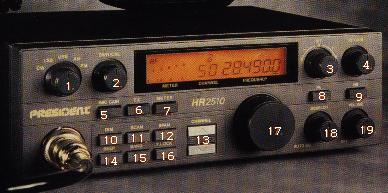
2. SWR CAL - Adjust the calabration of the SWR meter wile in the SWR CAL mode.
3. RIT Control - The Receiver Incremental Tuning control is used to fine tune the received signal.
4. RF Gain Control. - Varies the RF input to the receiver and helps eliminate strong, adjacent signals.
5. Mic Gain. - Selects a lower Mic gain level.
6. TX Switch - Locks the transmitter in the on position.
7. Meter Switch - Selects either RF/S, MOD, SWR CAL, or SWR.
8. PA Switch - Selects the PA Mode if an external PA speaker is connected.
9. NB Switch - Helps eliminate interference generated by vehicle ignition systems.
10. Dim Switch - Selects the level of the backlight of the display.
11. Scan Control - Used to scan up to 50 channels in each band segement.
12. Span Control - Select 10 KHz, 1 KHz, or 100 Hz steps for the VFO.
13. Channel ↑ ↓ - Step up or down to the next 10 KHz channel in the currently selected band segement.
14. Beep Selector - Press this switch to casue a short beep tone to be transmitted whenever you release the PTT switch. [also known as a "Roger Beep"]
15. Band Control - Selects one of four band segements.
16. F. Lock - Disables all frequency controls [except RIT] to prevent accidental changes of frequency.
17. VFO Control - Digital Variable Frequency Oscillator control used to select the desired frequency.
18. Squelch - Used to eliminate the "rushing" noise between transmissions.
19. Volume Control - Turns the unit on or off and adjusts the volume.
 The buttons on the 2510 can be hard to see where they are pointing. You can put something
in the notches to make them easier to see where they are pointing. My personal favorite is
a yellow crayon. Just grind it into the notch, and use a rag or paper towel to get
the excess of the face of the knob (and sides if you're sloppy). I've also seen people use
white-out. The nice thing about using wax is it can be removed, and nobody can even tell it
had anything in it.
The buttons on the 2510 can be hard to see where they are pointing. You can put something
in the notches to make them easier to see where they are pointing. My personal favorite is
a yellow crayon. Just grind it into the notch, and use a rag or paper towel to get
the excess of the face of the knob (and sides if you're sloppy). I've also seen people use
white-out. The nice thing about using wax is it can be removed, and nobody can even tell it
had anything in it.